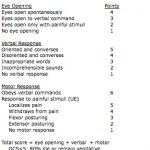I previously wrote about a new review that looked at using chemical prophylaxis for deep venous thrombosis (DVT) in patients with traumatic brain injury (TBI). The authors showed that it was safe to give subcutaneous heparin products within 24 to 48 hours after a stable 24 hour followup CT.
A just-published article now helps to refine the selection of the heparin product. A retrospective review looked at 386 ICU patients with a head Abbreviated Injury Score (AIS) > 2. A total of 57 received mechanical prophylaxis, the remainder received heparin products. Chemical prophylaxis consisted of subcutaneous enoxaparin 30mg bid or unfractionated heparin 5000u tid, at the whim of the attending neurosurgeon.
The heparin group had a slightly but significantly higher Head AIS (4.1 vs 3.8). The drugs were started at the same time post-injury, about 48 hours from admission. Unfractionated heparin was found to be inferior to enoxaparin. The unfractionated heparin patients had both a higher rate of pulmonary embolism, and were more likely to have progression of any intracranial hemorrhage (12% vs 5%). The authors claim a significantly lower DVT rate, but information in their data tables do not support this. Additionally, their overall DVT rate is very low, most likely because they did not routinely screen for it.
Bottom line: The head injury / DVT prophylaxis literature is expanding rapidly. It’s time to start working with your neurosurgeons to initiate chemoprophylaxis early (within 48 to 72 hours from injury once any intracranial bleeding is stable). And it looks like the drug of choice is enoxaparin, not unfractionated heparin.
Reference: Safety and efficacy of heparin or enoxaparin prophylaxis in blunt trauma patients with a head abbriviated injury severity score >2. J Trauma 71(2):396-400, 2011.
Related post: Brain injury and chemical prophylaxis for DVT

